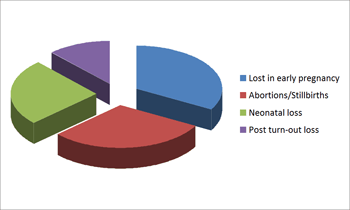How many live lambs are you hoping there will be this year?
Date: 8/3/2012
Lambing time is extremely busy time for flockmaster’s. Preparations actually started way back just after weaning the last crop of lambs. The coming weeks will inevitably be tiring and hectic; the ultimate aim is to have as many thriving lambs as possible to rear. Unfortunately, along the way there will always be losses, some are avoidable, if not this year then in following years.
The bigger picture: Looking at the overall flock performance is vitally important if something is to be done to reduce loses. The fact is few farmers’ record what is happening at lambing time with a view to put a finger on this, looking at the number of barren ewes and lambs lost is the key.
Why so? Losses due to abortion caused by diseases figure highly in the flocks overall underperformance. This is not just lambs being lost at lambing time i.e ‘stillbirths’, mummified lambs, misfortunes, and sickly lambs which often will not thrive or survive!
There is a need to account for dead lambs and empty ewes including those picked up at scanning, losing lambs in early pregnancy most probably due to disease. Flocks with a barrenness rate of more than 2-3% are likely to have a disease problem. However, most farms tolerate barrenness rates of between 5% and 10%!
If ALL losses were taken into account then it has been estimated annual loses for UK flocks exceeds of 1 MILLION lambs!. This could be reduced considerably, if measures are taken on a flock by flock basis.
Charted below is a summary of the main diseases causing abortions:-

| Lost in early pregnancy | 33% |
| Abortions/Stillbirths | 30% |
| Neonatal loss | 25% |
| Post turn-out loss | 12% |
Two main diseases dominate: Enzootic Abortion and Toxoplasmosis, both are obviously serious and it is estimated that 75 % of flocks have one or both of these diseases at some time.
The disease which probably presents the most long-term and ongoing danger is undoubtedly Enzootic Abortion! This is an infectious transmissible disease (Chlamydia psittaci) passed via from infected ewe to her lambs and to ‘clean’ ewes. Once infected the disease lies dormant (latent) until those ewes becomes pregnant and will inevitably means they will also abort at their next lambing. The extended problem is that these ewes will lamb successful, if given another chance. However, these ewes will continue to excrete the organism at each subsequent lambing in their amniotic fluids infecting others. We see ewes close to lambing licking other ewe’s fluid and even their lambs! The risk is passing on and spreading the disease to non-infected ewes in close proximity is HIGH.
The fact is most flocks have a ‘grumbling’ disease problem, with the added risk of possible devastating abortion storms. At lambing time it is often too late, some lambs may be saved by treating the ewes with long acting antibiotics, although not a long-term answer to control Enzootic Abortion.
Toxoplasmosis is the second most common disease causing abortions, it is serious, little can be done at this lambing time other than the use of medicated feed (consult your vet). This infection is due to a parasite (Toxoplasma gondii), this disease is not spread from sheep to sheep.
For more information on tackling abortion problems speak to your vet
Information on abortion control is also available on www.sheephealthplanner.co.uk/abortion this section is devoted to the subject and includes a NEW calculator to help evaluate the overall cost of these losses – control is often very cost effective.
Best Practice: Most flocks will have or should have a flock health plan in place; within this there should be a procedures to manage suspected abortions.
Measures to adopt would include the following:
- Act promptly: Isolate all suspected cases of abortion immediately!
- Identify the cause: Collect aborted material – keep separate and send off for testing (2-3 samples will help identify the cause).
- Bio-security: Clean and disinfect the area. Take care when handling ewes and aborted material, ALWAYS clean and sanitise hands, especially pregnant women and children, as these are particularly risk being infected.
- Contact your vet: Discuss possible courses of action.
- Identify and record: Ewes ID and number of dead/mummified lambs
- Be vigilant: Keep an eye out for other cases
Assume the worst until proven otherwise!
Take the time to calculate the cost visit www.sheephealthplanner.co.uk/abortion and decide upon a course of action to reduce the loss with your vet.

